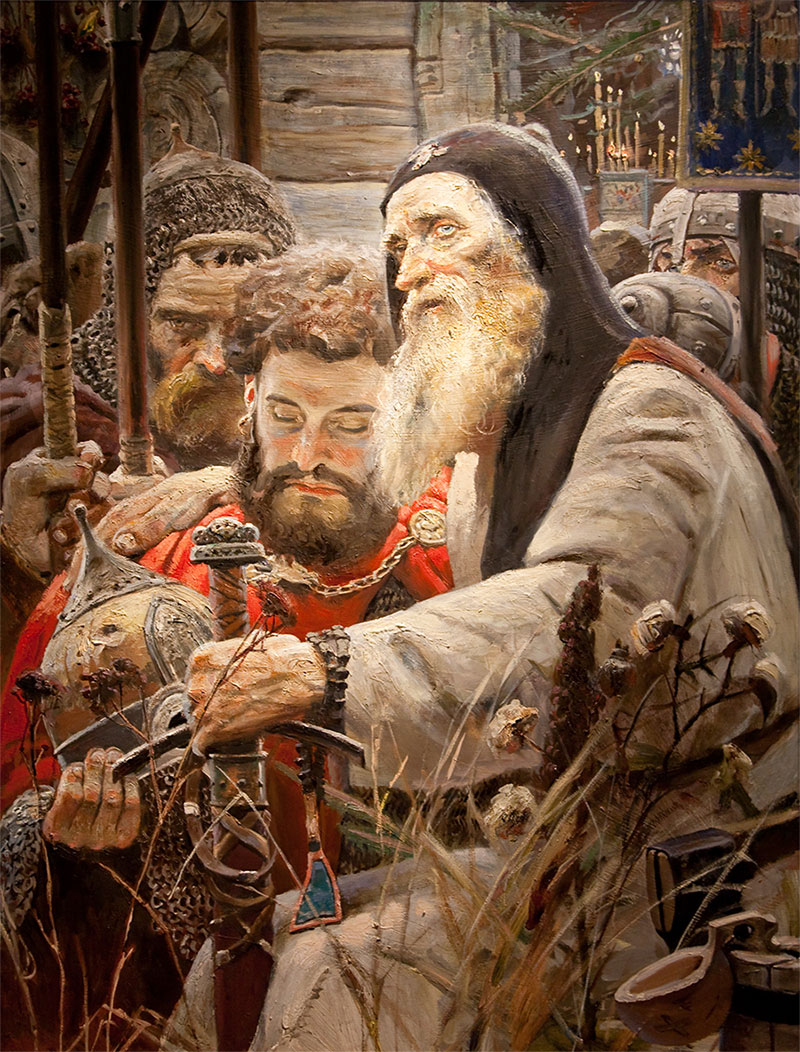. . . to awaken within her people an
appreciation and a re-adoption of the good and heroic things from her
past. This is exactly what the painter
Mr Ryzhenko has done in Russia. His
exceptional life is recounted below.
Paul
Ryzhenko (1970-2014) was a peculiar artist, especially for our times. He was
staunchly realist—he believed that realism was the only ‘real’ art and
scoffed at modernism as the result of a morally deteriorating world—yet he
was also an unabashed Christian and a deep idealist.
Intensely,
rebelliously, Pavel definitely did not believe in art for art's sake.
Instead,
he believed in art for God's Sake and for Russia's sake.
For God's Sake:
Ryzhenko always
said that he became Christian 'very late' ( he was 23!), but when he did,
he embraced it with characteristic fire:
Everyone
person, but especially the Russian, in the depths and mystery on one's heart,
gravitates to the light - to Christ.
To
me, faith in Christ came very late, but, once I believed, I wanted to run after
him, hoping sometime to come near to that light.
But
it to speak of people, those who have left and those who are still alive, who
are the carriers of the faith and spirit of the Russian Empire… is necessary for me - I must.
He
credited his conversion to his grandmother, who though senile, crippled and
uneducated, would always turn towards the window and exclaim "Mother of
God!" He would later say:
Grandmas
- are windows to that other Russia, a Russia where the phrase "that's your
problem"
did not exist
Indeed, after
he was baptized at age 23, Pavel immediately decided to leave the world and
become a monk. He spent some time as a novice in the great northern monastery
Valaam, but realized that monasticism was not his path.
His
family, later, became his 'promise of paradise' on earth, as he would
say.
But
Pavel Ryazhenko still drew monks very often, always in a misty, peaceful
quiet. Some people even teased him, despite the obvious fact that he had
a wife and children, that he was like a monk himself.
His
love and awe for monasticism lends a luminous light to most of his
canvasses, a haunting ideal of a contemplative life of prayer and peace.
For Russia's Sake
People
were also always surprised by how quickly he worked, a hurricane of paint and
activity that resulted in huge, colorful canvases in days: perfect in their
furious, mute motion.
Those
who knew him often say that he gave all his energy, physical, emotional and
spiritual, to his expansive paintings, so massive that they didn't even 'fit
into normal museums'. The Russian Revolution, the topic of many
of his later paintings, especially pained and tortured him.
Many
say that it was this furious, untiring habit of work that led to his premature
death at age 44.

Perhaps,
the sharp sense of immediacy he worked with came from Pavel's deep
personal conviction that his work was necessary, now, for his country
and the salvation of the souls of his countrymen, to reawaken the Russian, the
Christian in each person who came to look.
To
speak these things on canvas--because that is my duty before the great truth of
Russia.
It’s
my duty to allow the still-not-fully-broken city dweller. see, how, again
and again, these strict and loving faces of our ancestors reappear, those who
spilled their sweat and blood for Christ and each one of us.
He
believed that artists often veered into lives of passion and sin, wasting their
creative potential to awaken the passions in people or please people.
Meanwhile, he believed that the artist must approach his art like service.
Rizhenko
was notoriously unmaterialistic, only getting himself a 'normal' car two years
before his death. Supposedly, he didn't really advertise his exhibits either,
believing God would send the right people anyway.
He
was right; the tickets to his exhibits always sold out quickly.
He
was often upset about how Russians forgot their own heritage and looked to the
West for direction.
I
don't identify with the common-European culture, cosmopolitan culture, but with
the culture, which threads back to the centuries of the apostles, through Byzantium into Russia."
The Past
Most
obsessively, Paul Ryzhenko drew scenes from the past—battlefields, saints and
criminals—endowing it with a spiritual chord that gives the historical
images a new dimension.
For
this, he was often criticized by his contemporaries as too 'backward.' But
he would just say:
I
think, the most relevant genre of historical comprehension...there is nothing
more relevant.
In
order to answer the question “how can we go on?” I bring in examples of
history.
Its
a movement neither forward, nor backward, but towards
the soul, towards your own history.
Moving
towards an Orthodox monarchy, which, in my opinion, is the only honest form,
absolutely free in the margins of the law of God.
The future
Paul
lived with an expectation that the Russian people would reawaken, by returning
to the truths of Orthodoxy, and he thought of his paintings as
'steps' into the church.
It's
honorable to be "a step, a servant of God. And beyond Church, there's already Eternity.
One
of his last works was a huge, unconventional fresco of the Last Judgment.
At
the center of the composition is Pavel himself - a sinner awaiting, with
trembling, the moment of Judgement.
--Liza Ivanov, https://russian-faith.com/culture/zealous-artist-holy-russia-passionate-patriot-and-monarchist-meet-pavel-ryzhenko-n1184
More
about his life:
More
of his paintings are shown at the first address (the Liza Ivanov article) as
well as at this site:
May God grant rest to the soul of His
servant Pavel, and may He grant the same ghost that he possessed to one of our
Southern kinsmen very soon.
--
Holy Ælfred the Great, King of England,
South Patron, pray for us sinners at the Souð,
unworthy though we are!
Anathema to the Union!


No comments:
Post a Comment